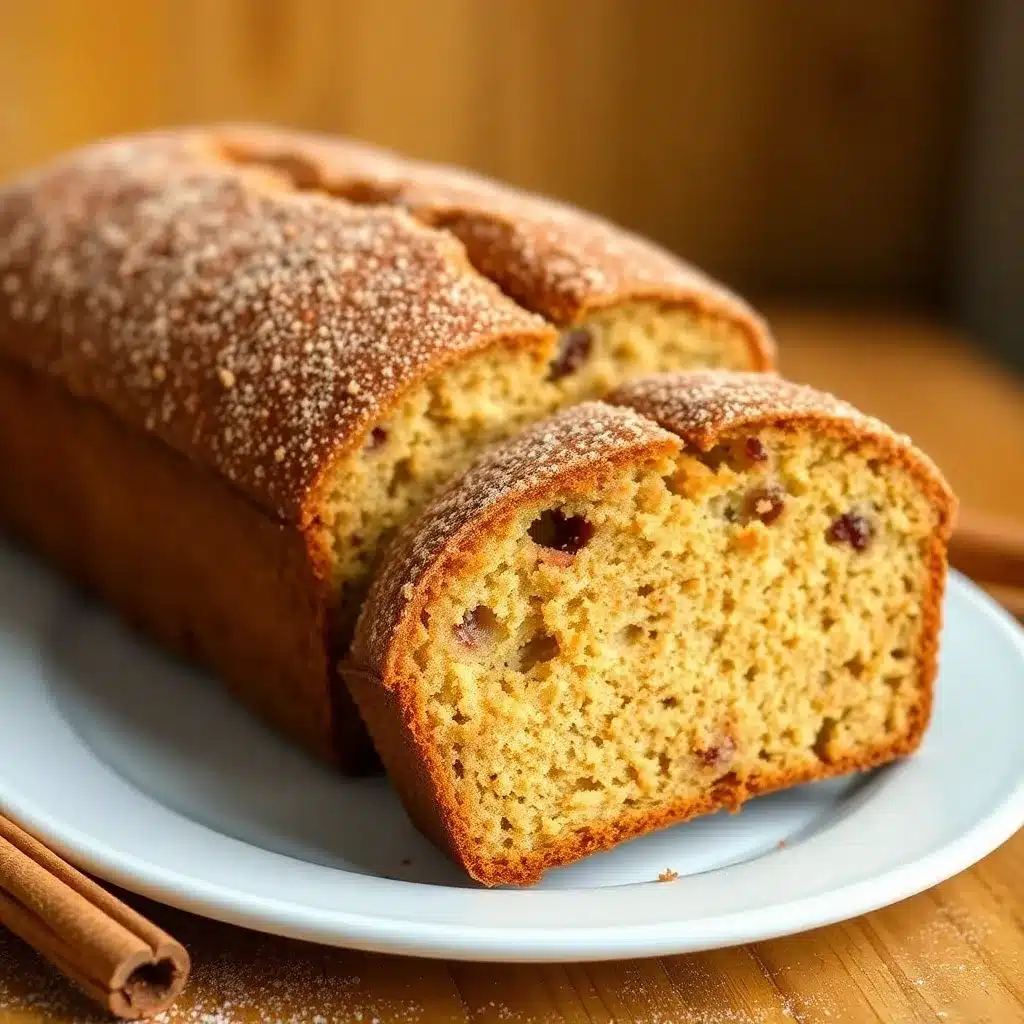Cinnamon Donut Bread has this strange way of reminding you of childhood fairs and bakeries at the same time. One bite and suddenly you’re back in a kitchen where cinnamon hangs heavy in the air, and sugar melts on your tongue before you even know it. It’s not a donut, not a bread, but a weird and lovely hybrid that straddles both worlds without apology.
Cinnamon Donut Bread is special because it mimics the soft crumb of cake donuts yet bakes in a loaf pan like a classic quick bread. No frying mess. No oil splatters. Just a golden crust kissed with cinnamon sugar that crunches lightly as you break through it. Professional bakers adore it because it’s a comfort food recipe that can be plated elegantly or sliced casually for coffee tables.
Ingredients & Substitutions
Cinnamon Donut Bread thrives on balance. Too much sugar and it cloys, too little and it falls flat. The essentials are simple: flour, sugar, butter, eggs, milk, baking powder, cinnamon, vanilla, and a pinch of salt. That’s the spine. Mess with it too much and the loaf loses its donut soul.
Cinnamon Donut Bread starts with flour. All-purpose flour works perfectly because its moderate protein ensures tenderness without chew. Bread flour would create a denser loaf, and cake flour risks collapsing under the sugar weight. If gluten is an issue, a high-quality gluten-free blend with xanthan gum steps in surprisingly well.
Cinnamon Donut Bread demands real butter. Not margarine, not oil, but butter that melts and seeps into the crumb. The milk solids in butter brown slightly during baking, creating notes of caramel that oil just cannot fake. Salted butter can be used if that’s all on hand, but drop the pinch of salt elsewhere.
Cinnamon Donut Bread benefits from whole milk, though you can swap for buttermilk if you crave tang or almond milk if dairy is off the table. Eggs are non-negotiable—room temperature eggs emulsify the batter better than cold, preventing that dreaded dense streak. And please, real vanilla extract, not the imitation stuff that smells like a candle store.
Cinnamon Donut Bread has cinnamon, obviously, but it’s worth stressing—buy good cinnamon. Saigon cinnamon gives sharper, hotter notes, while Ceylon offers lighter, floral whispers. Both are fantastic but create very different bread personalities. Professionals often blend the two for depth.
Step-by-Step Instructions
Cinnamon Donut Bread begins with creaming butter and sugar until pale and fluffy. This step isn’t optional. It whips air into the batter, laying the foundation for the tender crumb. Skip it, and the loaf will sulk in heaviness. Scrape down the bowl constantly because butter clings like it owns the place.
Cinnamon Donut Bread batter moves forward with eggs, beaten in one at a time. Professionals know that rushing here curdles the mixture, so patience is key. Once smooth, in goes vanilla, followed by a sifted mix of flour, baking powder, cinnamon, and salt. Sifting matters. Nobody loves a bitter clump of baking powder in their morning slice.
Cinnamon Donut Bread comes together when milk is added gradually, alternating with dry ingredients. This prevents overworking the gluten and keeps the batter silky. At this point, resist the urge to overmix—it’s better to see a faint streak of flour than to stir until the batter tightens up. Overmixing equals tough bread.
Cinnamon Donut Bread bakes at 350°F (175°C) for 45–55 minutes. The top should dome slightly, golden brown with a whisper of crackling crust. Insert a toothpick in the center—if it comes out with moist crumbs, you’re golden. Dry crumbs? Overbaked. Gooey batter? Back in the oven.
Cinnamon Donut Bread earns its donut status after baking. While still warm, brush the loaf with melted butter and shower it with cinnamon sugar. The butter soaks in, the sugar clings, and suddenly that humble loaf transforms into something carnival-worthy. Skip this step and it’s just cinnamon bread. Do it, and it’s Cinnamon Donut Bread.
Cooking Techniques & Science
Cinnamon Donut Bread relies on aeration science. Creaming butter and sugar traps microscopic air pockets, which expand in the oven, producing lift. Without this, the loaf sinks into mediocrity. Think of it as baking’s version of scaffolding.
Cinnamon Donut Bread uses baking powder as the chemical leavener. Double-acting powders release carbon dioxide twice: once during mixing and again with heat. This dual action creates steady rise and prevents collapse. Professionals understand the importance of fresh leavener—old powder equals flat bread, no matter how perfect your mixing.
Cinnamon Donut Bread gets its characteristic tenderness from fat. Butter coats flour proteins, preventing them from forming too much gluten. Less gluten means softer crumb, almost cake-like. Swap in oil, and the bread loses that delicate structure but gains extra moisture. This is why some bakers sneak half butter, half oil—best of both worlds.
Cinnamon Donut Bread sugar crust works due to hygroscopic magic. Sugar draws moisture, so brushing butter first ensures it clings instead of slipping off. Over time, the crust softens slightly, infusing into the loaf like a glaze. This is why day-two slices often taste even better than day-one.
Cinnamon Donut Bread also teaches restraint with cinnamon. Cinnamon is volatile and can turn bitter when baked in high concentrations. That’s why the spice shows up in balance—some inside the loaf, some dusted outside. It creates layers of aroma instead of one-note punch.
Serving & Pairing Suggestions
Cinnamon Donut Bread slices beautifully. Serve thick slabs with coffee for breakfast, or cut into thinner slices for afternoon tea. The sugar crust glimmers when plated under soft light, making it deceptively elegant for dinner parties.
Cinnamon Donut Bread loves toppings. Try a drizzle of cream cheese glaze for decadence, or spread softened butter with a sprinkle of flaky salt. Professionals sometimes serve it with spiced whipped cream or even caramel drizzle when presenting as a plated dessert.
Cinnamon Donut Bread pairs beautifully with drinks. Black coffee balances the sweetness, chai echoes the spice, and cold milk brings nostalgia. For a bolder match, a tawny port or spiced rum actually works—it bridges the sugar-cinnamon warmth like a winter hug.
Cinnamon Donut Bread travels well too. Wrap tightly in parchment, and it holds moisture for days. Toasting leftover slices in a skillet with butter revives them, giving caramelized edges that rival fresh-baked.
Conclusion
Cinnamon Donut Bread isn’t just a recipe. It’s a little masterclass in baking science disguised as comfort food. It shows how air, fat, sugar, and spice collide to create something that feels familiar yet extraordinary.
Cinnamon Donut Bread reminds us that great recipes don’t always need fancy techniques or rare ingredients. Sometimes, a loaf pan, butter, and a little cinnamon are enough to make people pause, smile, and maybe ask for seconds.
Cinnamon Donut Bread is professional-friendly yet homey, versatile yet dependable. Whether you’re serving it with wine, tea, or a simple glass of milk, it never feels out of place. And that’s the true magic—bread that makes you feel like a kid but tastes like it belongs on a chef’s menu.
FAQs
How do I prevent Cinnamon Donut Bread from turning dense?
Don’t overmix once the flour goes in. Overworking the batter develops too much gluten, making the bread chewy instead of soft.
Can I make Cinnamon Donut Bread ahead of time?
Yes. It keeps well for 3–4 days wrapped tightly at room temperature. The flavor deepens after a day, though the sugar crust softens slightly.
Can I bake Cinnamon Donut Bread in mini loaves or muffins?
Absolutely. Just adjust the baking time—20–25 minutes for muffins, 30–35 for minis. Watch for golden tops and the toothpick test.
What’s the best way to reheat Cinnamon Donut Bread?
Slice and warm in a skillet with butter, or toast lightly. Microwaving softens the crust but works in a pinch.
Can I add mix-ins like nuts or fruit?
Yes. Pecans, walnuts, or diced apples work beautifully. Just fold them in gently before baking, no more than 1 cup total to avoid weighing the loaf down.

Olivia P. is a seasoned food blogger at Tastywink, sharing delicious, easy-to-follow recipes inspired by him passion for home cooking. With years of culinary blogging experience, he brings flavor, creativity, and a personal touch to every dish.
